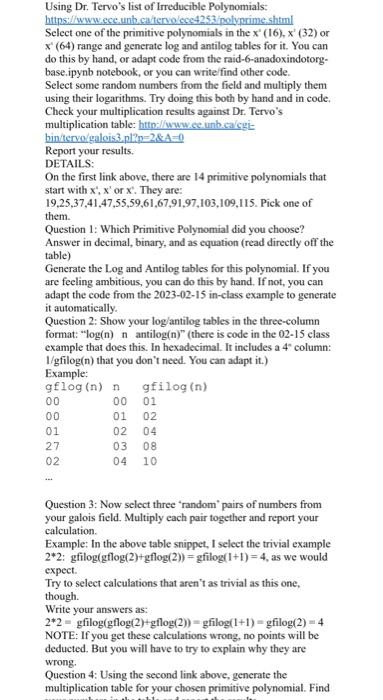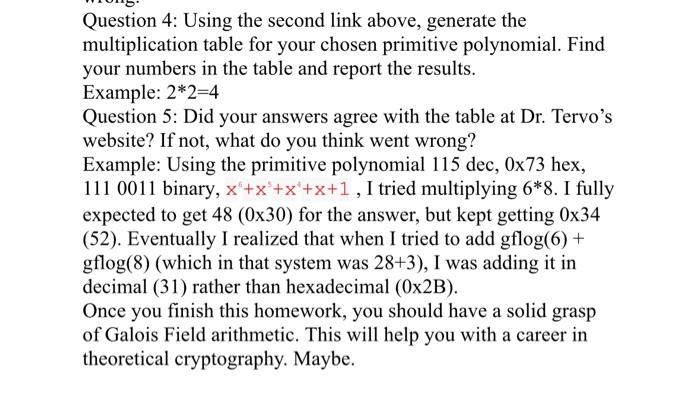Using Dr. Tervo's list of Irreducible Polynomials: hitns: fi wwwece unb, cartervoicce4253/polyprime shtmI Select one of the primitive polynomials in the x (16), x (32) or x(64) range and generate log and antilog tables for it. You can do this by hand, or adapt code from the raid-6-anadoxindotorgbase.ipynb notebook, or you can write find other code. Select some random numbers from the field and multiply them using their logarithms. Try doing this both by hand and in code. Check your multiplication results against Dr. Tervo's multiplication table: httn-i/wwweceunberalcgt- binderyokgalois 3,plpp=2&A=0 Report your results. DETAILS: On the first link above, there are 14 primitive polynomials that start with x4,x7 or x. They are: 19,25,37,41,47,55,59,61,67,91,97,103,109,115. Pick one of them. Question 1: Which Primitive Polynomial did you choose? Answer in decimal, binary, and as equation (read directly off the table) Generate the Log and Antilog tables for this polynomial. If you are feeling ambitious, you can do this by hand. If not, you can adapt the code from the 2023-02-15 in-class example to generate it automatically. Question 2; Show your log/antilog tables in the three-column format: "log(n) n antilog( n )" (there is code in the 02-15 class example that does this. In hexadecimal. It includes a 4 column: l/gfilog(n) that you don't need. You can adapt it.) Example: Question 3: Now select three "random" pairs of numbers from your galois field. Multiply each pair together and report your calculation. Example: In the above table snippet, I select the trivial example 2*2: gfilog(gflog (2)+gflog(2))=gfilog(1+1)=4, as we would expect. Try to select calculations that aren't as trivial as this one, though. Write your answers as: 22=g filog (gflog(2)+gflog(2))=g filog (1+1)=g filog (2)=4 NOTE: If you get these calculations wrong, no points will be deducted. But you will have to try to explain why they are wrong. Question 4: Using the second link above, generate the multiplication table for your chosen primitive polynomial. Find Question 4: Using the second link above, generate the multiplication table for your chosen primitive polynomial. Find your numbers in the table and report the results. Example: 22=4 Question 5: Did your answers agree with the table at Dr. Tervo's website? If not, what do you think went wrong? Example: Using the primitive polynomial 115dec,073 hex, 1110011 binary, x6+x3+x4+x+1, I tried multiplying 68. I fully expected to get 48(030) for the answer, but kept getting 034 (52). Eventually I realized that when I tried to add gflog(6)+ gflog (8) (which in that system was 28+3 ), I was adding it in decimal (31) rather than hexadecimal (02B). Once you finish this homework, you should have a solid grasp of Galois Field arithmetic. This will help you with a career in theoretical cryptography. Maybe








